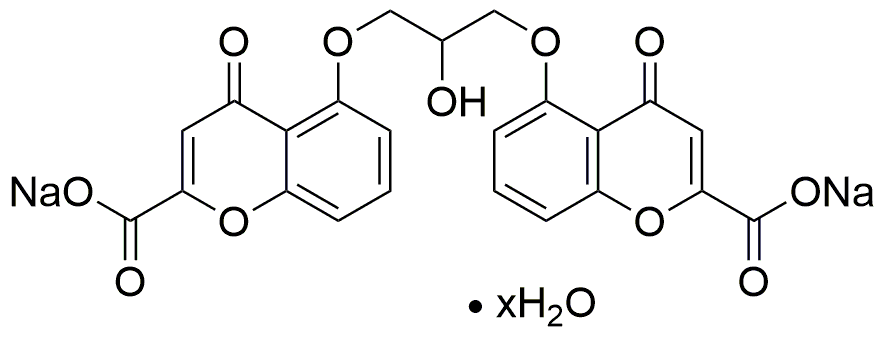Cromolyn disodium salt hydrate is widely utilized in research focused on:
- Allergy Treatment: Commonly used in inhalers and nasal sprays, it helps prevent allergic reactions by stabilizing mast cells and inhibiting the release of histamine, making it effective for asthma and allergic rhinitis.
- Pharmaceutical Formulations: This compound serves as a stabilizing agent in various drug formulations, enhancing the stability and efficacy of active ingredients, particularly in respiratory therapies.
- Research on Inflammation: It is employed in laboratory studies to investigate mechanisms of inflammation and allergic responses, providing insights that can lead to new therapeutic approaches.
- Veterinary Medicine: Used in treating allergic conditions in animals, it helps manage symptoms of allergies in pets, ensuring their comfort and well-being.
- Food Industry Applications: As a food additive, it can be utilized to improve the stability of certain food products, helping to maintain quality and extend shelf life.
General Information
Properties
Safety and Regulations
Applications
Cromolyn disodium salt hydrate is widely utilized in research focused on:
- Allergy Treatment: Commonly used in inhalers and nasal sprays, it helps prevent allergic reactions by stabilizing mast cells and inhibiting the release of histamine, making it effective for asthma and allergic rhinitis.
- Pharmaceutical Formulations: This compound serves as a stabilizing agent in various drug formulations, enhancing the stability and efficacy of active ingredients, particularly in respiratory therapies.
- Research on Inflammation: It is employed in laboratory studies to investigate mechanisms of inflammation and allergic responses, providing insights that can lead to new therapeutic approaches.
- Veterinary Medicine: Used in treating allergic conditions in animals, it helps manage symptoms of allergies in pets, ensuring their comfort and well-being.
- Food Industry Applications: As a food additive, it can be utilized to improve the stability of certain food products, helping to maintain quality and extend shelf life.
Documents
Safety Data Sheets (SDS)
The SDS provides comprehensive safety information on handling, storage, and disposal of the product.
Product Specification (PS)
The PS provides a comprehensive breakdown of the product’s properties, including chemical composition, physical state, purity, and storage requirements. It also details acceptable quality ranges and the product's intended applications.
Certificates of Analysis (COA)
Search for Certificates of Analysis (COA) by entering the products Lot Number. Lot and Batch Numbers can be found on a product’s label following the words ‘Lot’ or ‘Batch’.
*Catalog Number
*Lot Number
Certificates Of Origin (COO)
This COO confirms the country where the product was manufactured, and also details the materials and components used in it and whether it is derived from natural, synthetic, or other specific sources. This certificate may be required for customs, trade, and regulatory compliance.
*Catalog Number
*Lot Number
Safety Data Sheets (SDS)
The SDS provides comprehensive safety information on handling, storage, and disposal of the product.
DownloadProduct Specification (PS)
The PS provides a comprehensive breakdown of the product’s properties, including chemical composition, physical state, purity, and storage requirements. It also details acceptable quality ranges and the product's intended applications.
DownloadCertificates of Analysis (COA)
Search for Certificates of Analysis (COA) by entering the products Lot Number. Lot and Batch Numbers can be found on a product’s label following the words ‘Lot’ or ‘Batch’.
*Catalog Number
*Lot Number
Certificates Of Origin (COO)
This COO confirms the country where the product was manufactured, and also details the materials and components used in it and whether it is derived from natural, synthetic, or other specific sources. This certificate may be required for customs, trade, and regulatory compliance.

